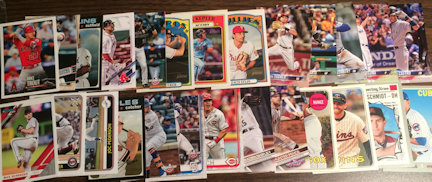This series touches on those events of 50 years ago to which would directly or indirectly affect 1974 Topps Baseball.
Monday October 22, 1973
On the day after the World Series ended, A’s manager Dick Williams announces his resignation; The A’s managerial situation will not get resolved for several months and there is no A’s manager card in 1974 Topps.
The California Angels traded Steve Barber, Ken Berry, Art Kusnyer (not in 74T), Clyde Wright and cash to the Milwaukee Brewers for Ollie Brown, Joe Lahoud, Skip Lockwood, Ellie Rodriguez and Gary Ryerson (not in 74T).

Barber would not play for the Brewers; he’d get released at the end of spring training, hook up with the Giants and make 13 relief appearances for them.



Brown was sold to the Astros at the end of spring training, so he never played for the Angels.



Tuesday October 23, 1973
The Boston Red Sox traded Ben Oglivie to the Detroit Tigers for Dick McAuliffe. Oglivie had appeared in 1973 Topps and would appear in 1975 Topps, but not in 1974.

Wednesday October 24, 1973
The Boston Red Sox traded Marty Pattin to the Kansas City Royals for Dick Drago.


Thursday October 25, 1973
The Chicago Cubs traded Fergie Jenkins to the Texas Rangers for Vic Harris and Bill Madlock.



The San Diego Padres traded Mike Caldwell to the San Francisco Giants for Willie McCovey and Bernie Williams (not in 74T).


The San Diego Padres purchased Matty Alou from the St. Louis Cardinals. Alou is shown in pinstripes because the Cards had purchased him from the Yankees on September 6th. (I’ve always liked this card for reasons I can’t fully explain)

Friday October 26, 1973
The Boston Red Sox traded Reggie Smith and Ken Tatum (not in 74T) to the St. Louis Cardinals for Bernie Carbo and Rick Wise.



The St. Louis Cardinals traded Tommy Cruz (not in 74T) and cash to the Texas Rangers for Sonny Siebert.

Saturday October 27, 1973
The Los Angeles Dodgers purchased Rick Auerbach from the Milwaukee Brewers. The Brew Crew had worn pullover jerseys in 1972 and 1973, so this might be an older photo.

This post, as originally written, went from Monday, October 22nd to Sunday, October 28th. The week that follows, Monday, October 29th to Sunday, November 4th has only one event of significance happening, so I decided to extend this week by a few days.
Wednesday, October 31, 1973
The Houston Astros traded Jerry Reuss to the Pittsburgh Pirates for Milt May.


Both players are wearing jerseys which are distinctive in their own subtle way. Reuss’ modestly airbrushed Astros jersey has a zipper-front which few 1970s teams had (Phillies were the other one that I can think of). May’s jersey is a pullover with a crewneck collar that was was used by just the Pirates and Cardinals. By the end of the decade, all pullover jerseys would have V-neck collars.







































































